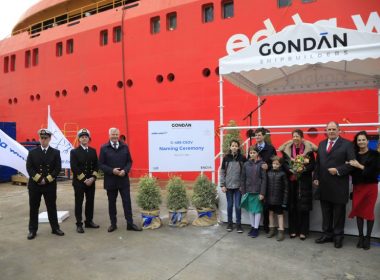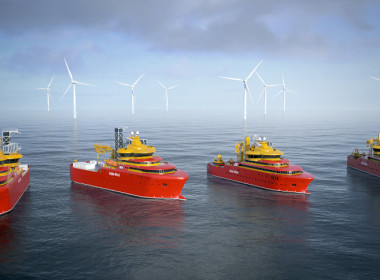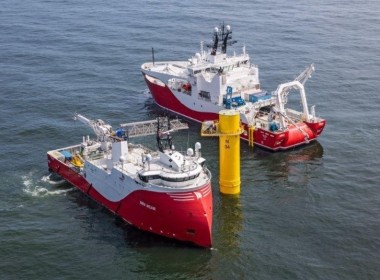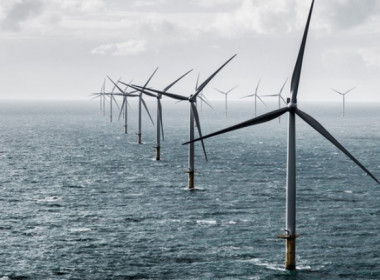COLUMN | Where the wind blows, part 2: Shell, Cadeler, HEA Energy, Cyan Renewables, Edda Wind, Norwind and Norside [Offshore Accounts]

In Part One last week, we looked at the paradox of offshore wind, a segment that is growing without profit for many players. This contrasts with offshore oil and gas, which has shrunk but has become intensely profitable for rig and vessel operators, and for the oil companies themselves.
Whereas offshore oil and gas companies are now at the point in the cycle where they throw off cash and pay down their debts, windfarm ship owners are entering the most capital-intensive and most dangerous phase of their industry cycle: a wind industry cycle where the customers for the ships are feeling pain, but the windfarm vessel owners seem oblivious.
Turbine manufacturer Siemens Gamesa, for example, is not forecasting break even until 2026! The costs of the wind turbines makes up around half of the overall cost of wind power (before accounting for tax benefits), or around two thirds including associated financing costs, Nolan Lindquist has estimated.
Shell exists South Korean project, Ørsted advances in Poland
The activity levels in offshore wind remain solid along with the future orderbook, even as the turbine makers bleed money and high-profile projects are delayed or cancelled. Following exits from floating wind projects in Ireland and France, Shell announced last week that it was also exiting a South Korean floating wind project, Reuters reported. Shell agreed to sell its 80 per cent stake in the 1.25GW MunmuBaram project off the coast of Ulsan to its joint venture partner Hexicon for US$5 million and a share of future profits from the project.
But this bad news was overshadowed by a big contract award in the Baltic. Last Tuesday, Cadeler announced that it had signed a contract with Ørsted and PGE Polska Grupa Energetyczna for the transport and installation of 59 of the 14MW Wind Turbines supplied by Siemens Gamesa Renewable Energy in 2027.
In January, rival Fred Olsen Windcarrier was awarded the first contract for the project for one its wind turbine installation vessels (WTIVs), which will install the first 48 of the 107 turbines. PGE and Ørsted plan to complete the commissioning of the Baltica 2 project, which has over 1.5 GW capacity, by the end of 2027.
Poland is one of the most polluting states in Europe, with coal‑fired electricity generation accounting for around 80 per cent of total power generation in the country, so the planned development of nearly six GW of offshore wind farms by 2028 is a major step to clean up the country’s air. The Baltica wind farm will be situated in the Polish sector of the Baltic between Łeba and Ustka, and the closest turbines will be at least 25 kilometres offshore.
No pricing was given by either Cadeler or Fred Olsen for the charter rate Ørsted will be paying for their WTIVs.
Cadeler plans as Hassan El Ali creates a new liftboat player
We have to say that we admire the optimism of Cadeler, flush from its merger with Eneti, which brought together Cadeler’s existing two WTIVs with Eneti’s two existing vessels. As a result of reward for the merger, Eneti seems to have paid out some US$60 million to the usual suspects in its senior management and on its shareholder register as “a change of control fee,” even though its genius managers wrote down US$48 million when selling three older, smaller WTIVs to HEA Energy of Abu Dhabi at the same time.
The buyer is Hassan El Ali
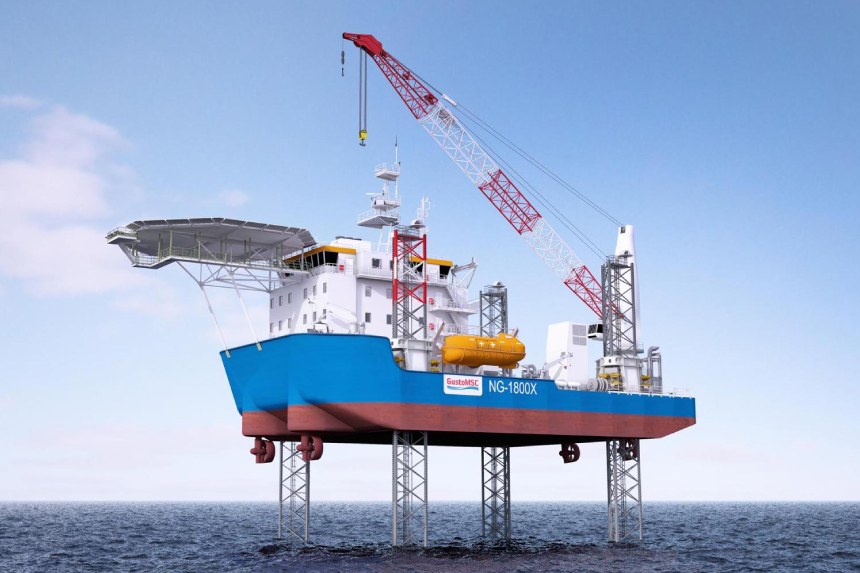
HEA apparently stands for Hassan El Ali, the founder of Zakher Marine International, which he sold to ADNOC Logistics and Services in 2022, leaving his son Ali El Ali as CEO under the new owners. Clearly, the formation of HEA Energy and the acquisition of the trio of Eneti jackups sees a comeback for the veteran Syrian marine entrepreneur.
Indeed, in January, HEA Energy sold two four-legged DP2 jackups, Pluto 1 and Pluto 2, to ADNOC Logistics & Services, GustoMSC NG1800X design units. HEA Energy also bareboated the GustoMSC NG2500x design liftboats Venus 1 and Venus 2 to ADNOC L&S last year.
We wonder how long it can be before the three former Eneti units are also sold by the father to his son’s company and are gracing the shores of Abu Dhabi.
Eneti/Cadeler is complicated
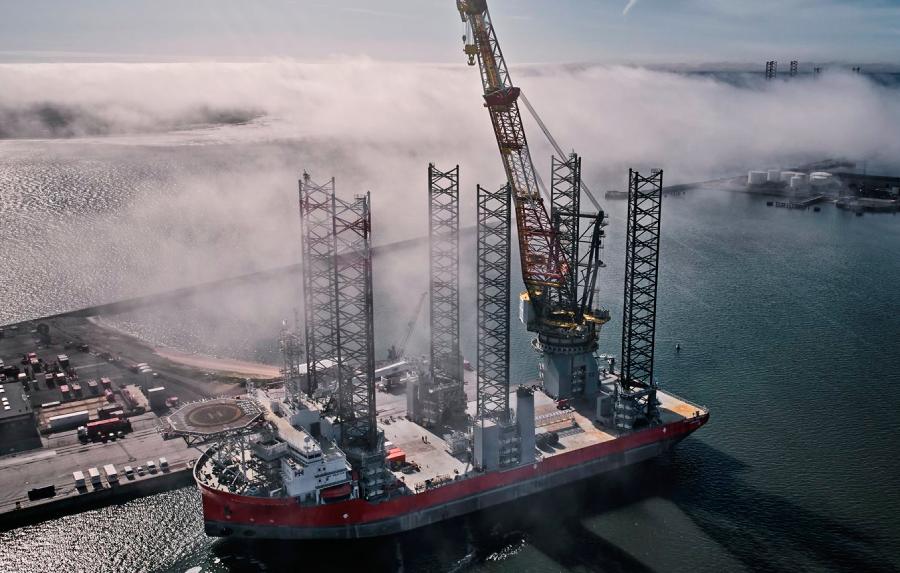
The Eneti/Cadeler merger closed at the same time that both of Cadeler’s existing units were out of service for crane upgrades, which is work ongoing in the Netherlands at the time of writing. Without the Eneti merger, Cadeler would have had very little revenue in the fourth quarter of last year or the first quarter of this year, and a huge cash outlay.
The installation of the 1,600-ton leg crane on board Cadeler’s WTIV Wind Osprey was completed last week when the crane boom was installed. This followed the completion of the crane upgrade for sister vessel Wind Orca earlier this month. Mammoet showcases the boom in a great video here. Now the wires must be reeved, and the cranes commissioned.
But the excitement (and Eneti’s pressing need to perform the transaction) was driven by the large newbuild orderbook of the two companies, not the existing fleet. When the deal closed, Cadeler had two WTIVs on order in China, plus two wind turbine foundation installation vessels (WFIVs, with an “F”), and Eneti had two WTIVs on order in Korea. Few of the units were contracted, despite the total debt requirement of over US$1.5 billion needed to pay for them all.
Market runs out of free WTIVs in 2027
Cadeler itself has always admitted that the demand for WTIVs is not actually expected to outpace supply until 2027, which is a pretty shocking admission, even with the long lead times for newbuilds. If you don’t believe me, that statement is there in plain sight in the company’s Oslo Stock Exchange filing last week.
Despite the fact that its customers are firing their senior executives and bleeding cash, writing down projects and slowing down windfarm developments, the release shows some hints of optimism:
“Cadeler believes it has healthy employment prospects for its A-Class Wind Foundation Installation newbuild vessels (previously referred to as F-Class Wind Foundation Installation vessels), which are optimised for transportation and installation of offshore wind foundations. The attractiveness of the A-Class vessels are, among others, evidenced by the company’s contract at Hornsea 3 announced by the company on April 23, 2023, which is set to utilise one of Cadeler’s A-Class vessels and which Ørsted took a positive Final Investment Decision on, as announced on December 20, 2023.”
Thus, Cadeler has now disclosed that it has entered into a letter of intent with COSCO regarding the construction of a third WFIV at the Chinese yard. The company’s first two two P-Class WTIVs are set to be delivered in the third quarter of 2024 and the second quarter of 2025, respectively, and two A-Class WFIVs are scheduled to be delivered in Q4 2025 and the second half of 2026, whilst the Eneti-ordered newbuilding M-Class WTIVs have deliveries planned for Q1 2025 and Q4 2025.
Quite how the company will operationally manage the increase in its fleet from four units to ten is not clear, but now it has plans to increase its fleet to eleven. If Ørsted thinks it is vulnerable to interest rate movements (here), as he claimed two weeks ago, just look at Cadeler.
However, Cadeler is building a dominant position in wind installation, both in fleet size and in specifications. The company highlights how the three A-Class vessels will be able to transport up to six XL monopile foundations (each weighing approximately 2,300 to 2,600 tonnes and having a diameter of up to approximately 12 metres) per load, which improves operational efficiency for its customers significantly, it claims.
Boskalis and DEME go for the monohull WFIV
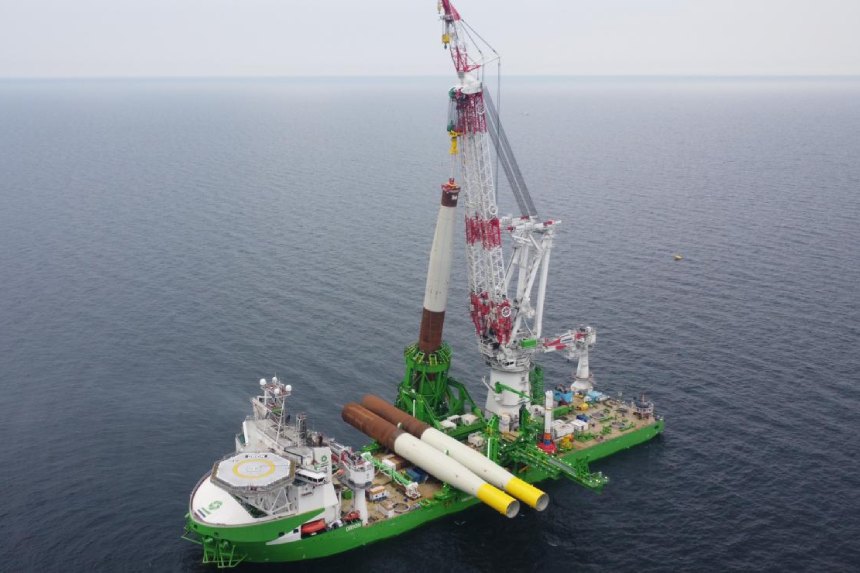
Boskalis, meanwhile, has gone for a completely different and much lower capex approach, converting existing DP2 monohulls for foundation and monopile installation, requiring none of the jackup legs of Cadeler’s WFIVs. It is not clear to me whether the higher-cost Cadeler units have operational advantages, which would make them more efficient than Bokalift-1 and Bokalift-2, and analysts appear not to be querying Cadeler on why it is so confident to be betting a billion dollars on a different technology to Boskalis.
DEME has also opted for a monohull WFIV, and its new build Orion is fitted with a 5,000 tonne crane, significantly larger than the capacities of Cadeler’s newbuild units.
Time will tell.
US$166 million raised, US$240 million to borrow
The expected vessel cost of the Cadeler A-class order at letter of intent stage is estimated to be in the range of US$390 million to US$410 million, far higher than previous WTIVs, with expected delivery in Q1 2027. Mid-month, the company closed a private placement supported by its largest shareholders, the BW group of Hong Kong, and Scorpio Holdings of Monaco. This raised US$166 million through the allocation of 39.5 million new shares. There’s still the matter of the remaining US$240 million of debt that needs to be raised.
Cadeler is a pureplay wind farm company. Its main rivals – Subsea 7 and the big four integrated dredging and construction companies from the Low Countries DEME, Boskalis, Jan de Nul, and Van Oord – are diversified, with strong oil and gas businesses also included. A slowdown in offshore wind would harm these companies, but not fatally. Both DEME and Boskalis are keen to highlight that their WFIVs can also install and decommission small offshore oil and gas platforms.
It seems hard to believe that Cadeler can prosper even as its main customers suffer horribly. Are Siemens Gamesa and Ørsted really honourable enough to bleed money, whilst Cadeler makes out like a bandit?
This would never happen in oil and gas, where both the international majors like ExxonMobil and Shell and the national oil companies like Saudi Aramco and Qatar Energy routinely bully and squeeze their contractors and vessel owners whenever there is a slowdown and the oil price is weak.
Perhaps wind really is different?
Others clearly believe so
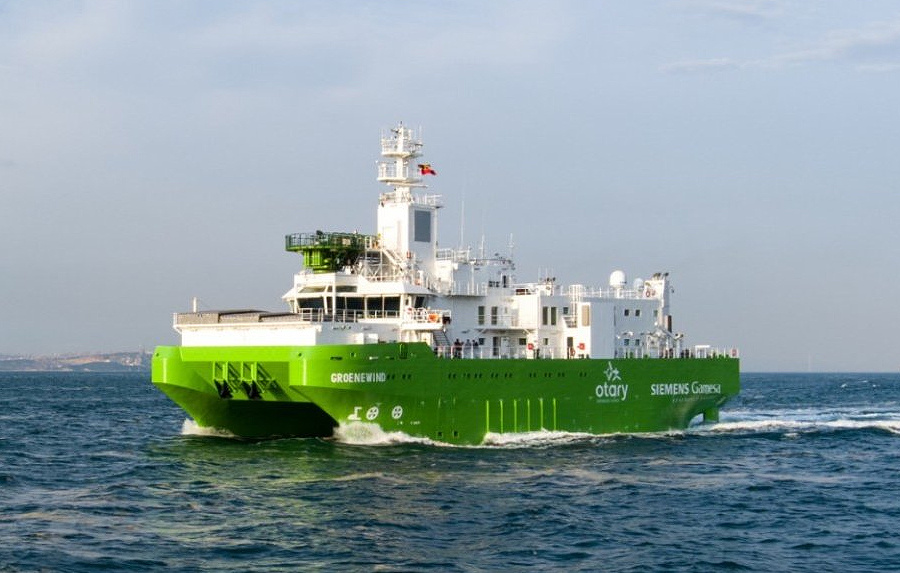
Whilst Cadeler was celebrating its private placement and letter of intent for its eleventh vessel, Singapore’s investment company Cyan was celebrating another win. Readers will recall that Cyan has aspirations to own renewables assets worth one billion US dollars and has been busy buying first the service operation vessel (SOV) Groenewind from DEME, on a long term charter with Siemens Gamesa out of Oostende, as Baird reported in 2021, and then 75 per cent of Scottish emergency response and rescue vessel owner Sentinel Marine last month. DEME said it would report a one-off gain on the sale when it announced its full year results in July, but those have not yet been released. No figures for the price of Sentinel were disclosed.
Despite Cyan’s announcement on April 25 last year that it had signed a letter of intent (LOI) at COSCO Shipping Heavy Industry to build its first WFIV, nothing more has been heard of the LOI being firmed up into an actual newbuild contract.
In fact, one wonders why Cadeler didn’t just take the Cyan slot.
Cyan wins a newbuild SOV charter
But now, Cyan has signed its first newbuilding contract – at Vard in Vietnam for a hybrid 85.5-metre SOV, which will be built against a long-term contract with Siemens Gamesa to support the Hai Long Two offshore wind farm in Taiwan (here).
The 15-year charter will commence in 2026 when the wind farm comes on line, and Cyan’s SOV will service the 73 Siemens Gamesa SG 14-222 DD design turbines that will be installed approximately 25 nautical miles off the coast. The construction approval permit was issued last year.
One hopes that there is plenty of inflation protection for Cyan as Taiwan’s great wind boom has demonstrated a lack of trained local seafarers with offshore experience and DP skills, driving up crew costs. Historically, in oil and gas booms, vessel owners have underestimated cost pressures on long-term, fixed-price charters.
Edda sells one of its SOVs, delivers another
The sale by DEME of an SOV on a long-term charter was matched earlier this month by the news in an Oslo Stock Exchange filing that Edda Wind was selling its 2018-built SOV Edda Passat to parties currently unknown for an unknown price. Edda Passat had operated for Ørsted at Race Bank Offshore Wind Farm since it was built in 2018, but that charter expired in October last year. Edda Wind then entered into an agreement with Vestas for a short-term charter over the last three months of 2023, and latterly the vessel has been working in the German Bard wind farm.
Edda Wind owns and operates three purpose-built offshore wind SOVs and three commissioning SOVs (CSOVs), and also has eight dedicated offshore wind vessels under construction – one SOV and seven more CSOVs. A few days before the sale was announced, Edda Wind announced that the company’s CFO has resigned, which is never a good look.
At the same time as it was selling Edda Passat, Edda Wind was also “excited to announce” on social media that its SOV Edda Goelo had departed Astilleros Balenciaga shipyard in Spain and that yard sea trials are set to commence shortly.
What do we know for certain about the excitement of a newbuild delivery? There’s also the excitement of handing over a final payment to the yard.
Edda Wind shares are down, drillers are up
Whilst Edda Goelo will commence operations for Siemens Gamesa on a five-year charter at Iberdrola’s offshore wind farm in the Saint-Brieuc Bay in France after delivery, it is hard to avoid the impression that the company might have needed some deleveraging ahead of the delivery. Unlike Cadeler, it had not hit in its shareholders for additional equity. Indeed, the shares have closed down 18 per cent over the last year and are down 30 per cent since the company listed in late 2021. Cornerstone investors John Fredriksen and Idan Ofer would have done better to have sipped cups of diet tea and stayed away from the company’s IPO. In the same period, shares in offshore driller Valaris have doubled, and rig owner Noble’s stock is up 80 per cent.
Edda Wind’s fourth quarter results for 2023 will be released on February 29, 2024. The sale of the SOV closes in March. We will avoid speculation until then. However, with such a large orderbook, some deleveraging is perhaps necessary. Despite its six vessels in service, Edda only made a net income of less than US$2 million across the first nine months of the year.
So far, like Cadeler, this is a bet on future profits rather than earnings today.
Our concern – profitless growth
Our concern remains that these long-term wind farm support contracts are not very profitable as too many companies like Cyan, chasing the offshore wind dream, are driving down rates. Long-term charters are always vulnerable to operating cost inflation (Ask Havila about its long-term charters for its PSVs with Equinor in Norway.).
Wind is growing fast, but so far, few players have demonstrated any meaningful profitability, either operating offshore wind energy projects, selling wind turbines, constructing wind farms, or owning and chartering crewboats or SOVs.
Shipyards and equipment manufacturers, however, are performing very nicely from the boom in wind. Billions of dollars are being invested in dozens of CSOVs and SOVs, and in WTIVs and WFIVs.
With the offshore oil and gas orderbook still painfully small despite the global fleet age problem, perhaps the builders and equipment deserve their moment in the sun.
Background reading
The return of Hassan El Ali to the offshore industry with HEA Energy less than a year after selling Zakher to ADNOC reminds us how many times in shipping and offshore an owner sells a fleet and then immediately re-enters the business.
Cross-town rival to Zakher, Stanford Marine, was formed after the offshore support fleet of GMMOS was sold to Seabulk in 1997, at which point current Stanford CEO Elias Nassif set up a small company with two vessels and then sold it back to GMMOS, which then built up a new fleet. GMMOS was bought by two local investment funds in 2009 and renamed Stanford Marine in 2011 with Mr Nassif still at the helm. The Reeves family sold their company Minnow Marine Projects and its fleet of ten platform supply vessels (PSVs) to GMMOS in 2009, and then founder Robin Reeves promptly started Marine Assets Corporation, which took some bold bets on newbuildings semi-subs and PSVs in China (history here and here).
In Singapore, Pang Yoke Min first founded and sold Jaya Holdings, with several partners, then founded Pacific Radiance in 2012. In America, the Hornbeck family headed by Larry Hornbeck sold their first offshore company to Tidewater in 1996, but retained rights to the name of that firm, and founded the second Hornbeck Offshore in 1997, led by Larry’s son Todd. Hornbeck will shortly re-list on the New York Stock Exchange as we reported here. Burdened with debt, Pacific Radiance was sold to Mexico’s ENAV in 2021, which succeeded in flipping the remainder of the Pang fleet to AD Ports in November last year for US$200 million.
And, of course, when it comes to asset-flipping as an art form, nobody does it better than the Norwegians. Hans Martin Gravdal managed to sell not one, but two subsea companies – first selling the Geo Group to DOF in 2005, which became one of the foundations of DOF Subsea, and then Seabed to Swire Pacific Offshore in 2012, which ended up closing the business in early 2020 after years of losses. Mr Gravdal is now CEO of, and investor in, Norside Wind, which owns three walk-to-work vessels converted for the windfarm industry.
Similar to the Edda Wind IPO, one can’t help but wonder whether Norside would not have done better to have kept the PX121 design PSV Farland, which it bought in January 2022, as a PSV, rather than converting it for offshore wind service as Norside Cetus. Hindsight has 20:20 vision, but so far returns in wind have been underwhelming. Farland was originally built by Ulstein Verft and delivered as Blue King in 2016, before it was purchased by Sverre Farstad.
Sverre Farstad is another Norwegian shipping magnate making a comeback. He renamed this ship Farland in 2019, when he bought the vessel after his equity in Farstad was wiped out in the downturn and forced merger with Solstad. In 2021, Mr Farstad made a second comeback as an investor in a CSOV startup named Norwind Offshore, which promptly places four new orders at Vard. Norwind Helm was formally launched in Romania, earlier this month (video). The Norwind CSOVs have a length of 85.5 metres, a beam of 19 metres, and accommodations for 87 people.
NOV specifications for the Gusto NG1800X design liftboat are here and the NG2500X specifications are here – these are the designs of liftboats that Mr El Ali senior sold and bareboated to his son’s company.
With offshore entrepreneurialism spanning the generations and running in the blood, we await the arrival of the wind dynasties.


